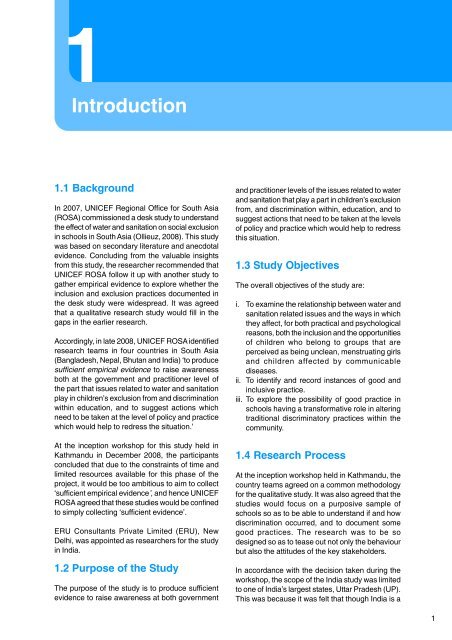Equity in School Water and Sanitation
Equity in School Water and Sanitation
Equity in School Water and Sanitation
Create successful ePaper yourself
Turn your PDF publications into a flip-book with our unique Google optimized e-Paper software.
Overcom<strong>in</strong>g Exclusion <strong>and</strong> Discrim<strong>in</strong>ation <strong>in</strong> South AsiaIndia Country Report1Introduction1.1 BackgroundIn 2007, UNICEF Regional Office for South Asia(ROSA) commissioned a desk study to underst<strong>and</strong>the effect of water <strong>and</strong> sanitation on social exclusion<strong>in</strong> schools <strong>in</strong> South Asia (Ollieuz, 2008). This studywas based on secondary literature <strong>and</strong> anecdotalevidence. Conclud<strong>in</strong>g from the valuable <strong>in</strong>sightsfrom this study, the researcher recommended thatUNICEF ROSA follow it up with another study togather empirical evidence to explore whether the<strong>in</strong>clusion <strong>and</strong> exclusion practices documented <strong>in</strong>the desk study were widespread. It was agreedthat a qualitative research study would fill <strong>in</strong> thegaps <strong>in</strong> the earlier research.Accord<strong>in</strong>gly, <strong>in</strong> late 2008, UNICEF ROSA identifiedresearch teams <strong>in</strong> four countries <strong>in</strong> South Asia(Bangladesh, Nepal, Bhutan <strong>and</strong> India) ‘to producesufficient empirical evidence to raise awarenessboth at the government <strong>and</strong> practitioner level ofthe part that issues related to water <strong>and</strong> sanitationplay <strong>in</strong> children’s exclusion from <strong>and</strong> discrim<strong>in</strong>ationwith<strong>in</strong> education, <strong>and</strong> to suggest actions whichneed to be taken at the level of policy <strong>and</strong> practicewhich would help to redress the situation.’At the <strong>in</strong>ception workshop for this study held <strong>in</strong>Kathm<strong>and</strong>u <strong>in</strong> December 2008, the participantsconcluded that due to the constra<strong>in</strong>ts of time <strong>and</strong>limited resources available for this phase of theproject, it would be too ambitious to aim to collect‘sufficient empirical evidence’, <strong>and</strong> hence UNICEFROSA agreed that these studies would be conf<strong>in</strong>edto simply collect<strong>in</strong>g ‘sufficient evidence’.ERU Consultants Private Limited (ERU), NewDelhi, was appo<strong>in</strong>ted as researchers for the study<strong>in</strong> India.1.2 Purpose of the StudyThe purpose of the study is to produce sufficientevidence to raise awareness at both government<strong>and</strong> practitioner levels of the issues related to water<strong>and</strong> sanitation that play a part <strong>in</strong> children’s exclusionfrom, <strong>and</strong> discrim<strong>in</strong>ation with<strong>in</strong>, education, <strong>and</strong> tosuggest actions that need to be taken at the levelsof policy <strong>and</strong> practice which would help to redressthis situation.1.3 Study ObjectivesThe overall objectives of the study are:i. To exam<strong>in</strong>e the relationship between water <strong>and</strong>sanitation related issues <strong>and</strong> the ways <strong>in</strong> whichthey affect, for both practical <strong>and</strong> psychologicalreasons, both the <strong>in</strong>clusion <strong>and</strong> the opportunitiesof children who belong to groups that areperceived as be<strong>in</strong>g unclean, menstruat<strong>in</strong>g girls<strong>and</strong> children affected by communicablediseases.ii. To identify <strong>and</strong> record <strong>in</strong>stances of good <strong>and</strong><strong>in</strong>clusive practice.iii. To explore the possibility of good practice <strong>in</strong>schools hav<strong>in</strong>g a transformative role <strong>in</strong> alter<strong>in</strong>gtraditional discrim<strong>in</strong>atory practices with<strong>in</strong> thecommunity.1.4 Research ProcessAt the <strong>in</strong>ception workshop held <strong>in</strong> Kathm<strong>and</strong>u, thecountry teams agreed on a common methodologyfor the qualitative study. It was also agreed that thestudies would focus on a purposive sample ofschools so as to be able to underst<strong>and</strong> if <strong>and</strong> howdiscrim<strong>in</strong>ation occurred, <strong>and</strong> to document somegood practices. The research was to be sodesigned so as to tease out not only the behaviourbut also the attitudes of the key stakeholders.In accordance with the decision taken dur<strong>in</strong>g theworkshop, the scope of the India study was limitedto one of India’s largest states, Uttar Pradesh (UP).This was because it was felt that though India is a1












